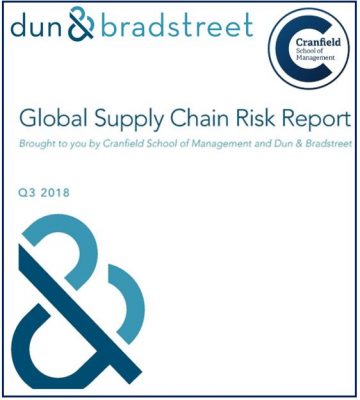Companies may be exploiting currency fluctuations caused by Brexit and other global geopolitical events. There could be a dividend for companies seeking to save money in their supply chain, says a team of researchers.
Dun & Bradstreet and the Cranfield School of Management published the ‘Q3 2018 Global Supply Chain Risk Report.’ Its authors investigated the level of perceived supply chain risk that European companies face with international supplier relationships.
The authors found that foreign exchange risk rose by 4% across the Wholesale, Infrastructure, Services, Manufacturing, and Finance sectors during Q3. They suggested that buyers could be taking advantage of the currency fluctuations to save money on purchases.
In Q3, the pound fluctuated from 0.91 to 0.88 per Euro. It fluctuated more during the third quarter than during the rest of the year. The euro also fluctuated against the dollar; from 1.18 to 1.13 US$ per euro during Q3.
The supply chain is the whole process of creating and selling commercial products. It includes all the stages, from the supply of components and raw materials to delivering the product to the final consumer.

Buyers exploiting Q3 currency fluctuations
Dr. Heather Skipworth said:
“Larger companies often hold the power in the buyer/supplier relationship, and decide whether to pay suppliers in local or foreign currency to maximize financial benefit.”
“During the past quarter, exchange rates across the world have been in a state of fluctuation, partly due to trade issues – not just Brexit, but also the U.S. trade war with China, for example. It seems that buyers may increasingly be seeing an opportunity to use these fluctuations for their own ends.”
Dr. Skipworth (FCILT, FHEA) is a Senior Lecturer in Logistics, Procurement and Supply Chain Management at Cranfield.
In Q3, firms in the financial services sectors have become more risk-seeking compared to wholesalers, manufacturers, and infrastructure companies.
If a person or company is risk-seeking, they like taking risks. Risk-seeking is the opposite of risk-averse.
Financial services companies
Chris Laws said:
“The analysis of Dun & Bradstreet data shows that the biggest increase in risk exposure during Q3 was amongst financial services companies, with three out of the four risk metrics increasing, a trend that has been building throughout 2018.”
Chris Laws is Dun & Bradstreet’s Head of Global Product Development – Supply & Compliance.
Everything went up for financial services companies
Both foreign exchange risk and global sourcing risk rose by 8% during Q3 for financial services firms. Since the beginning of 2018, both risks have increased by 31% and 13% respectively.
Supplier financial risk was five percent up over the past three quarters. During Q3, it remained at a steady high of 26.4%.
Wholesale trade sector
During Q3, the wholesale trade sector registered the largest reduction in risk exposure. Supplier criticality, supplier financial risk, and global sourcing risk were 9%, 6%, and 6% down respectively.
Foreign exchange risk, however, rose by 9%, reaching the highest levels of all sectors. Foreign exchange risk increased by 24% since the beginning of the year.

